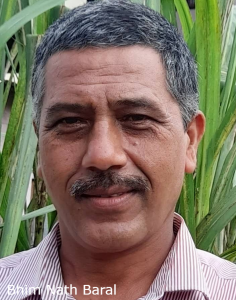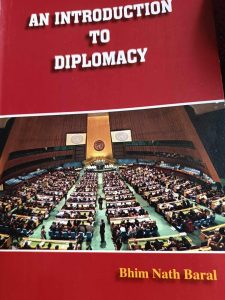Bhim Nath Baral
Associate Professor
Department of Political Science
Prithvi Narayan Campus,
Tribhuvan University, Pokhra, Nepal

Begin Text:
Different theories have been developed in the analysis of diplomatic intercourse. All arguments and demonstrations exhibited by the actors are measured by using a level of analysis approach (Jackson and Sorensen, 2013:256). This approach was first introduced by Kenneth Waltz in his study of the causes of war and amplified by J. David Singer who has offered three different sources of explanation. They are:
# A system (global) level analysis:
Theories at the systemic level explain diplomacy by pointing to conditions in the international system that compels or pressures states towards acting in certain ways. Foreign policy behavior is conceived as a reaction to the external environment (Holsti, 1978:17). Diplomatic dealings mainly determines on the bases of the distribution of power among states and their political and economic interdependence. Therefore, such analysis first need to say something about the condition that prevails in the international system; they then need to create a plausible connection between those conditions and the actual foreign policy behavior of state (Jackson and Sorensen, 2013:253). The role of universal actors, their structure, distribution of power, norms and values and the way of functioning are the major variables of the analysis of international system. Diplomacy is also viewed on the basis of word situation as whether it is tenseful or relaxed.
State level analysis:
States are the main actors of international politics and the world politics is studied from stand point of state level analysis. The explanation is derived from characteristics of the state: the type of government (democracy or authoritarianism), economic system (capitalist or socialist), and interest group within the country or even national interest (Mingst, 2004:59- 60). Domestic political, cultural, bureaucratic make up, role of competitive elite, economic group, interest group, social structure, opposition, public opinion etc. have their impact in foreign policy and diplomacy.
# Individual level analysis:
The personality, perception, choices and activities of individual decision maker have significant impact in diplomacy (Mingst, 2004:59). Diplomatic intercourse is highly influenced by the level of individual decision maker. His way of thinking, basic belief, personal priorities bring changes in diplomacy. The nature of human kind, his involvement in the organization and over all role of individual can affect in the working of international politics. Ideal individual and their view can guide the statesmen.
Further, Feilleux has presented three more levels of analyzing diplomacy. They are (2010:12-13):
# Transnational level: It represents a growing phenomenon fostered by technological developments, a greater awareness of international civil society and growing trends towards globalization. Several INGOs and NGOs can play their role in diplomacy.
# Professional level:
Professional level analysis represents individual’s participation in diplomacy which is no longer limited to members of the Foreign Service. The persons involved in various diplomatic profession have their own way of diplomatic interpretation.
# Functional level:
Functionalism believes that men are able to recognize, design and agree upon appropriate structure for each functional need. But this concept is used in a broader sense, not at all limited to function but including other elements such as structure and its way of functioning in examining the various modes of diplomacy currently in use.
Types of Diplomacy:
Transition from Old to New Diplomacy:
The post- renaissance period gave birth to the rise of several nation states. The period ranging from the appearance of the nation state system to the World War-I (1919) is generally termed as the era of old diplomacy. Though this type of division has no any scientific logic, however, the post First World War international system experienced new form of diplomatic intercourse. It was in 1918, Woodrow Wilson, the then American president, sought a slogan in diplomacy which we call it as open diplomacy. Though some of the scholars are of the opinion that to talk about the difference between old and new diplomacy is a popular illusion (Roy, 1978:52). They claim that human nature never changes and there is only one way of settling international differences. It is also said that the most persuasive method at the disposal of a government is a world of an honest man. It can’t be denied that diplomacy is a continuous process and its basic principles represent the accumulated experience of generation of wise and reasonable man.
Besides these, some scholars like Panikkar are interested in distinguishing between old and new diplomacy. He is of the opinion that the lesson of old diplomacy has already ended in 1914, beginning of the First World War, which formally ended the dominance of European state system (Roy, 1978:53). Nevertheless, no sudden change has taken place to contrast in the principle and methods of diplomacy. The gradual evolution in the methods and techniques of dealing in the art of negotiation itself is the product of change. Basically, the ambassador, then as now, was deemed to be the personal representative of the chief of the state in foreign country. It was mainly because of the absence of well- defined rules of procedures. But diplomacy has become an established profession and a generally accepted method of international intercourse in recent years. Maturity in diplomatic dealings is seen because of substantial changes occurred in global politics.
In spite of the lack of visible demarcation, the transition from old to new diplomacy was affected by several factors. According to Nicolson, three developments of the nineteenth and twentieth century have greatly affected the theory and practice of diplomacy. These are: (a) the growing sense of the community of nations, (b) the increasing appreciation of the importance of public opinion and (c) the rapid increase in communication (Quoted, Palmer and Perkins, 2015:93). In the same manner, Gandhijee Roy, in his book Principles of Diplomacy, has mentioned about the three major elements for the transition of diplomacy from old to new. They are: growing influence of colonialism, rapid commercial competition and rapid increase in communication (Roy, 1978:54). S.L. Roy, on the other hand, is of the opinion that the three trends which evolved in post renaissance period created the ground for new diplomacy. According to him, the general recognition accorded to a system of universally accepted international law established a general code of conduct which came to regulate interstate relation. Likewise, influence of the politico-military class, where diplomatic policies were developed and managed, was from the military rather than from the civilian point of view.
Further, the transition has passed through the development of trade and commerce (Roy, 1984:59-60).
To sum up, modern diplomacy has its root in the past. It is seen in various forms and nature but the fundamental objectives of diplomacy almost remain the same. It is natural to witness new diplomacy as gradual evolution and modification of diplomatic practice along with the change in the mode of civilization. However, we are in a new era of diplomatic practice.
Old and New Diplomacy:
Old diplomacy:
On the basis of time, techniques, practices, personnel involved in diplomatic dealings and other factors, diplomacy is categorized into different forms. Here, I am going to discuss about old and new diplomacy.
The traditional diplomacy is generally known as old diplomacy. No doubt, diplomacy in general is old as states and their relations. The system of diplomacy, which referred to as ‘traditional diplomacy’ is also identified as ‘old diplomacy’, ‘bilateral diplomacy’, ‘The French’ or ‘The Italian’ system of diplomacy (Ghosh, 2015:109). In the sense that, the diplomacy originated somewhere at the close of sixteenth century which continued up to 1918-19, was called as old diplomacy.

During this period diplomacy was concerned mainly with the building up of allies. But it was a ‘closed’ affair, not involving deep hatred or violent animosities as monarchical and aristocratic Europe was essentially one community with a deep- rooted feeling of Western European unity. The old diplomacy mainly was based on three schools of diplomacy in vogue in Europe during those centuries namely Italian (Venetians and Machiavelli), French (Grotius, Richelieu, Tallyrand etc.) and German (Metternich and Bismarck) (Malhotra, 2014:334). Whatever may be the label, old diplomacy is characterized by some distinctive features with regard to its purpose, structure, agenda and process broadly relating to the questions such as who is involved in diplomacy?, How are diplomatic activities carried out? What is the substance of diplomacy?
(Ghosh, 2015:109). Its characteristics can be summarized in the following points:
# It was Europe centric: Europe was the center of old diplomatic activities. It was mostly confined to Europe and non- European countries were either isolated or became subjected to colonization.
The five powers- England, France, Prussia, Austria and Spain were the main actors who could act in harmony to an unusual extent and hence the system was often referred to as the Concert of Europe. Therefore, diplomacy was virtually Euro-centric.
# Big power affairs: The five European powers had significant role in World politics. They were strong from both military and economic point of view. The small powers had few role to play. Their influence was based on the availability of market, raw material and geo- strategic location (Roy, 1978:58).
# Monopoly of aristocratic class: The diplomatic officers were selected or nominated by the monarch from the rank of the nobles and aristocrats. They were solely responsible to the king. They were not career diplomats recruited on merit through competitive exam (Malhotra, 2014:334).
Secrecy: Old diplomacy was characterized by secrecy. It was based on the assumption that secret diplomacy helps in the resolution of differences and arriving at an agreement. It is also believed that until diplomacy goes back into privacy, where there will be again the freedom to give and take that is necessary for any agreement, its success will continue to be negligible. So far the diplomatic intercourse was considered as the personal matter of king or absolute ruler, the negotiations were mostly kept secret. But the later generation had to bear very expensive pay of secret negotiations. Formation of Triple Entente and Triple Alliance before and after First World War can be taken as examples.
# Limited agenda: The agenda of old diplomacy was parochial and narrow in comparison to present era (Ghosh, 2015:109). More importance was given to the issues like war and peace, making friend and foe etc. Many talks were concluded on bilateral basis.
Limited actors: Very few actors had their role to be played in the game of world politics. World politics till 1919 was confined to Europe and Five European powers-Britain, France, Prussia, Spain and Austria had their dominating role.
Flexibility: The diplomacy in the past was flexible in nature. Because of the lack of fastest means of transportation and communication, it was extremely difficult for the monarch to keep constant touch with their diplomat in various states. They had to allow them a considerable freedom in matters of negotiations (Malhotra, 2014:335). The ambassadors/envoys used to exercise more rights in concluding negotiations. Even the monarchies used to change their camp frequently.
New Diplomacy:
Diplomatic practices took turning point during early twentieth century which demanded new methods as well as new personnel. Generally, the practice of new diplomacy began after the end of First World War. It was the post First World War period when international condition changed considerably and many monarchies were replaced by democratic governments (Malhotra, 2014:335). At the same time, tremendous change had occurred in the field of communication, transportation and other aspects of international life. Mass awareness arose among the people. There was numerical increase in the member of world community and they started to influence in the world affairs. The course of world affairs has drastically changed. The role of non-state actors and inter-state relation became the common nature in international system. The wave of independence flourished in Asia first and rest of African and Latin American world later. Before First World War, 16 countries of the world had their role in world politics. Out of them 15 were European. The situations became different after 1919. Nearly 50 countries had their role in world politics out of which more than half of them were non-European (Roy, 1978:66). It caused the diffusion of Europe centric power which assisted in the decline of old diplomacy.
Though President Wilson is considered as the first spokesman of open diplomacy, in reality, it was by the leaders of revolutionary Russia that this theory was put in practice for the first time in the history (Roy, 1984:61). Lenin and his associates started publishing all the Russian archives and secret treaties concluded by Czar. It gave a great blow at the secrecy and the confidential character of diplomatic negotiations (Roy, 1978:66-67). The newly established Soviet regime in a statement issued on 22nd November, 1917 declared, “The abolition of secret diplomacy is a primary condition of honesty in a popular and truly democratic foreign policy. To pursue that policy in practice is the task the Soviet government sets itself “(Roy, 1984:61).
Besides the above facts, a host number of factors have contributed in the emergence of New Diplomacy which replaced the old one. More important were the major events mainly occurred before or during the First World War. Rise of Socialist Soviet Russia, emergence of USA in world Politics as a major power, gradual awakening of Asia and entry of third world countries in global politics, enlightened public opinion, development in communication and transportation, transformation of world politics, growing popularity of conference diplomacy etc. were responsible for the arrival of new diplomacy. Its chief characteristics are given below:
# Internationalization of diplomacy- New diplomacy is international in nature. The gravity of world power has shifted away from Europe and extended to other parts of the World. Europe is no longer the exclusive center of international affairs and since the Second World War, power has become concentrated in the hands of two non- European states, the United States and the Soviet Union (Frankel, 1990:137).

Specialization- Generally, the ambassador is a generalist. He may not be able to show expertism to a subject of technical nature. To negotiate trade and technology, special team consisting of economic experts and scientists respectively are sent abroad. Likewise, the issue related to disarmament and arms control are settled by the specialists and peace researchers. So, new diplomacy is based on specialization.
The extended structure- To many extent, the structure of new diplomacy is similar to the old one.
However, modern diplomacy is also conducted by several non-state actors (Ghosh, 2015:111).
# Trend of summit or personal diplomacy- Option less traditional diplomacy now has changed into summit or personal diplomacy. Important issues are discussed by summit level. Political leaders of concerned countries directly deal rather by their professional diplomats. Direct contact and negotiation between heads of state or government and foreign minister in bilateral or multilateral arrangements, international conferences and meetings of international organizations are being used as the forum for diplomatic intercourse. They can take bold decision on the spot.
# Open diplomacy- The old diplomacy was secret in nature which was suspicious about the role of diplomacy. According to Woodrow Wilson, president of USA, the First World War was the product of secret diplomacy. So, he formulated the idea of open diplomacy in the very first of his famous fourteen points: “Open covenants of peace, openly arrived at, after which there shall be no private international understanding of any kind, but diplomacy shall proceed always frankly and in the public view” (Frankel, 1990:137). This view conveys three ideas: first, that there should be no secret agreements; second, that negotiation should be conducted openly and third, that after a covenant has been arrived at, no attempt should be made, behind the scene, to alter its provision secretly (Roy, 1984:61).
End text.
Text courtesy: From the book, “An Introduction to DIPLOMACY”, by Associate Professor Bhim Nath Baral, Department of Political Science, Prithvi Narayan Campus, Tribhuvan University, Pokhra.
# Published in the larger interests of those who wish to learn about Diplomacy.
# Published with the straight permission from the distinguished author Shri Bhim Nath Baral: Ed. N. P. Upadhyaya. # The distinguished author could be reached at: baralbhimnath@gmail.com
# Shortly to begin with Democratization of Diplomacy: Ed. Upadhyaya. N. P.
